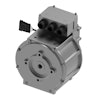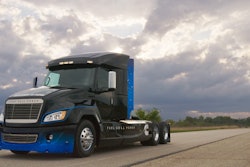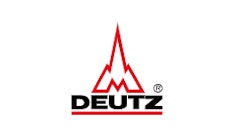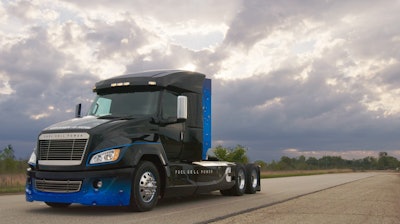
On November 16, 2020, Cummins Inc. held a Hydrogen Day virtual event during which it outlined its current and future initiatives focused on the development of hydrogen and fuel cell technology.
“There’s an incredible opportunity for Cummins to continue to build a strong business in hydrogen production and fuel cell technology, contributing to the lowering [of] emissions and protecting our planet,” said Tom Linebarger, Chairman and CEO of Cummins.
He said over the past 5 years the company has developed and acquired significant capabilities in electrified powertrains, battery design assembly, battery management, fuel cells and hydrogen generation. All of which had been done to meet the evolving needs of customers as well as the carbon reduction goals set out by the Paris climate accords. Linebarger said Cummins supports this accord and the many countries which have announced in recent years their goals of being carbon neutral by 2050.
The company has also set out its own science-based targets aligned with the Paris accord and target carbon neutrality by 2050. Linebarger said the company believes hydrogen will play a meaningful role in the transition toward decarbonization, which is why the company is dedicating much of its design efforts into this fuel option.
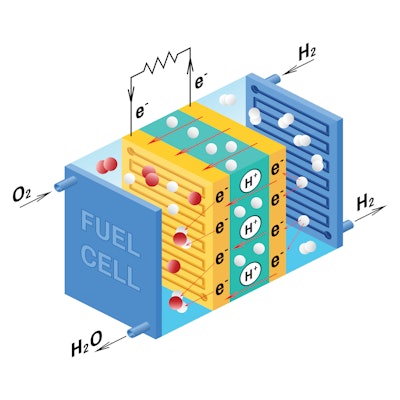 ©sivvector – stock.adobe.com
©sivvector – stock.adobe.com
Benefits of hydrogen
Linebarger said Cummins believes hydrogen will play a key role in decarbonizing the global economy because of the many benefits it provides. One of which is the fact that hydrogen is the most abundant element on earth. It is also light, storable, reactive and provides high energy per unit mass. He noted it is also a versatile fuel which can be transported as a liquid or a gas, and can be converted into electricity to power homes, transformed into methane for feedstock, or used as a fuel for transportation. “It offers ways to decarbonize energy-intensive industries like long haul transportation, shipping and industrial processes,” he said.
Hydrogen is also energy dense and enables renewable energy as it can balance the variable supply and demand of solar, wind, and hydro power, and can carry renewable energy long distances to power different regions, explained Linebarger.
Thad Ewald, Vice President, Corporate Strategy at Cummins, said 1 kg of hydrogen has the general energy equivalent of roughly 3 kg, or 1 gal., of diesel fuel. “So, compared to diesel or natural gas, hydrogen will be able to power a vehicle, the same distance, using less fuel.”
He added that the efficiency of a fuel cell system is approaching 60% today compared with about 50% for a diesel engine, and less for a natural gas one. “This means more of the energy put into a fuel cell is used to power the vehicle further reducing the amount of hydrogen needed to do the same amount of work, when compared to diesel or natural gas,” said Ewald.
In addition, hydrogen is ‘green’ in that it can be used and produced without direct emissions of air pollutants or greenhouse gases (GHG). “Without hydrogen being green, it cannot be a meaningful part of the solution as we move toward carbon neutrality,” said Linebarger. 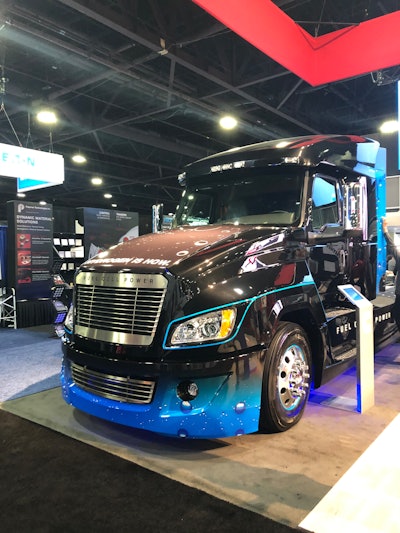 Cummins exhibited its hydrogen fuel cell powered concept truck at NACV 2019.S. Jensen
Cummins exhibited its hydrogen fuel cell powered concept truck at NACV 2019.S. Jensen
Hydrogen production can be categorized in many ways, but for the purposes of Cummins’ discussion on the technology, Linebarger would refer to it in terms of being gray, blue or green. He said almost all of the approximately 70 million tons of hydrogen produced today is considered gray hydrogen. This means it is generally produced by steam methane reforming which uses significant amounts of power through the use of natural gas. “This produces over 830 million tons of CO2 a year, which equates to more emissions than all of Germany,” he said.
Blue hydrogen represents about 1% of global production currently and is essentially gray hydrogen and the CO2 created in production is sequestered underground, generally in old gas fields. He said this reduces the CO2 emitted in the environment by 90%.
Green hydrogen, on the other hand, uses electrolysis to turn hydro, wind or solar power into hydrogen with zero carbon dioxide (CO2) emissions. Linebarger said only about 1% of hydrogen produced today is considered green. “This is the future of hydrogen production,” he said. “Electrolyzers are the key technology that enables green hydrogen production and Cummins is a key manufacturer. To replace the gray hydrogen used today with green hydrogen, the world would need roughly 3.2 terawatt hours of renewable power, resulting in over 350,000 megawatts of electrolyzer built out.”
READ MORE: Cummins to Open New Fuel Cell Systems Production Facility in Germany
According to Linebarger, the transition to a hydrogen economy will impact many industries—from power producers to transportation to other industries such as steel production. “The movement towards renewable power for electricity and green hydrogen for transportation and industrial applications will be key in helping us reduce CO2 emissions to achieve the Paris accord goals,” he said.
Cummins technology
In recent years, Cummins has acquired or formed partnerships with various companies to aid its development of hydrogen and fuel cell technologies. Through these initiatives, along with its own R&D efforts, the company has created a portfolio of electrolyzer systems for production of green hydrogen as well as fuel cell systems which power buses, trucks and trains, said Amy Adams, Vice President, Fuel Cell & Hydrogen Technologies at Cummins.
READ MORE: Cummins Closes Acquisition of Hydrogenics
Cummins’ fuel cell systems consist of multiple technology platforms to mee the unique needs of different industries, said Adams. The two key technologies are solid oxide fuel cells (SOFC) and proton exchange membrane (PEM); PEM are utilized in zero-emission vehicles of all sizes.
She said PEM fuel cells are ideally suited to transport operations because they operate at relatively low temperatures, have a quick startup time and fast dynamic response. They also provide a favorable power to weight ratio which is particularly beneficial in applications like heavy-duty trucking.
SOFC run at higher operating temperatures which better suits stationary applications.
Adams said Cummins’ PEM fuel cell products are already installed in more than 2,000 on- and off-highway applications across the globe. The fuel cell power modules have a low-pressure fuel cell stack design and integrated balance of plant. They also provide a flexible and reliable design for OEM customers and feature unlimited start-stop cycles.
Because PEM fuel cells must be humidified during operation, Cummins has made its fuel cells self-humidified using water produced during operation. This helps to ensure reliability of the system.
In addition, Adams said the fuel cells can be used in sub-zero conditions without the need to be plugged into heaters when vehicles are not in operation. Additional benefits she noted include the high energy density provided and flexible architecture of the fuel cells which can be combined in parallel to power larger vehicles.
Fuel cell power modules ranging from 8-45 kW of continuous power are available. Efficiency of the fuel cells is over 50% which she said outpaces diesel and natural gas engines, particularly in urban fleet duty cycles.
Applications in which the fuel cells have thus far been employed with customers include forklifts, garbage trucks, buses, drayage trucks and more. Standard and customized options are available, said Adams, as well as integrated fuel cell and electric powertrains. “This gives us the opportunity to work with a diverse customer base from OEMs to integrators,” she said.
READ MORE: Cummins Collaborating with Navistar Class 8 Truck Powered by Hydrogen Fuel Cells
Cummins can supply as many of the components necessary for an application. For a Class 8 drayage truck in California, for instance, it supplied a fully integrated package which includes the fuel cell, hydrogen storage, battery system and electric drivetrain.
High-pressure hydrogen storage solutions is a recent addition to the company’s offering which came about from its joint venture with NPROXX. “The joint venture will provide customers with hydrogen and compressed natural gas storage products for both on-highway, and rail applications,” said Adams. “And NPROXX’s advanced type four carbon fiber pressure vessel creates a superior strength and stiffness-to-weight ratio, resulting in a potential 450 kg weight reduction of gas containment systems in buses and trucks.
“Overall, Cummins is strategically investing in a range of technologies to be well positioned throughout the hydrogen supply chain, from alkaline and PEM electrolyzers for green hydrogen production to tanks and dispensing solutions to a suite of fuel cell power modules,” she added.
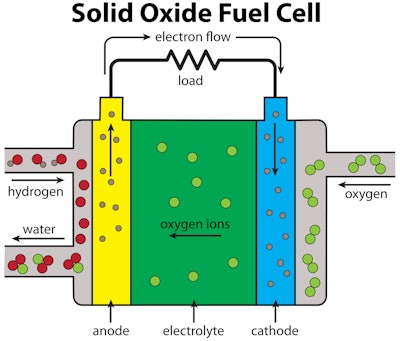 Solid oxide fuel cells run at higher temperatures, which makes them better suited for stationary applications.©Gregory – stock.adobe.com
Solid oxide fuel cells run at higher temperatures, which makes them better suited for stationary applications.©Gregory – stock.adobe.com
Production, cost and infrastructure remain challenges
While there are many benefits hydrogen can provide, there are still obstacles to be overcome before it can be a fully commercialized and widely adopted fuel. Ewald noted one challenge with hydrogen is that while it may be energy dense in terms of weight, it has low volumetric density. “Essentially, although it's very light, it takes up a lot of space,” he explained. “This makes onboard storage a critical component of hydrogen powered vehicles.
“To store enough hydrogen on a vehicle to meet range requirements you have to shrink the hydrogen down into a tighter space through either compression or liquefaction. Both are technically challenging today and represent a significant input into the cost of fuel cell vehicles,” he said. This is why the company is investing in advancing storage technology through its recently closed joint venture with NPROXX.
“We're really excited about hydrogen as a fuel source for transportation,” said Ewald. “And we're continually learning from both our fuel cells in the field, and from our ongoing work to better the enabling technologies that make it a viable solution.”
Cost is also a major concern, particularly for the green, renewable base hydrogen that Cummins and others would ideally like to use to aid decarbonization efforts. This version is more expensive than diesel or natural gas, and not much of it is currently available. Ewald said there are three key cost drivers that will reduce the price and increase availability of green hydrogen—energy prices, electrolyzer prices and distribution costs.
“The price of renewable power continues to decline, and we would expect that tend to continue as only around 25% of global electricity production is now renewable,” he said. “So there is continued opportunity in this space.”
The capital investment in electrolyzers is also a large cost input. However, as demand for them continues to increase their cost will come down as has been the case with other technologies.
Distribution costs will be dependent upon where the distance between where hydrogen is produced and where it will be used. As with any fuel, if locally produced there won’t be as far for it to travel to reach customers, and therefore costs will be lower. Proper distribution channels will need to be developed, as well as the refueling infrastructure to enable increased uptake of hydrogen as a fuel option.
 Fueling infrastructure will be a key component to enabling wider market adoption of hydrogen powered vehicles.©chesky – stock.adobe.com
Fueling infrastructure will be a key component to enabling wider market adoption of hydrogen powered vehicles.©chesky – stock.adobe.com
Market adoption will take time
While Cummins sees hydrogen as a key component in the transition toward decarbonization, the company also understands this technology will take time to develop and that it is not the only solution. This is why the company continues developing a variety of powertrain options for its customers. “With advanced diesel, natural gas, mild and heavy hybrid battery-electric and fuel cells all playing a role in the transition to purely carbon neutral technologies, we are well positioned to help our customers navigate through this transition and are seizing the opportunity,” said Amy Davis, Vice President & President, New Power at Cummins.
“Our goal is to have the right products to meet customers’ needs at every point of the transition, which is why we've invested in multiple solutions upfront for the majority of Cummins’ existing end markets,” she added.
Davis went on to say the company expects fuel cells will be the best option due to their long list of advantages. Cummins plans to pair its fuel cell technology with its battery-electric systems and controls, and believes it can be used in battery-electric, hybrid, diesel and natural gas applications. This flexibility will help the company accelerate its knowledge on the technology as well as enable it to build to scale common drivetrain components. This will help to make the systems more easily introduced and accepted in the marketplace.
The pace of commercialization for hydrogen and fuel cell products will vary by market and region, said Davis. Three main factors will drive adoption rates:
- Infrastructure – It will take time and resources to develop a system of fueling stations; adoption will likely begin first in markets where refueling can be done at a central location.
- Total Cost of Ownership (TCO) – Hydrogen solutions will need to have a TCO competitive with internal combustion engines.
- Regulations – Early adoption of hydrogen technology will need some form of government support since it is not yet as cost effective as traditional power systems.
She said in regards to regulations, there is starting to be more interest to support less carbon intensive technologies and address infrastructure.
The cost of fuel cells and hydrogen is projected to remain above that of internal combustion engines for at least 10 years. “We anticipate the adoption of fuel cells to begin in markets where the cost of these items as a proportion of their total cost of ownership are the lowest,” said Davis. “This is why we have focused on a market like trains, where the powertrain and the fuel costs represent 50% of the total operating cost, much lower than the heavy-duty truck market which is above 80%. There will be further considerations that end users will also have to make, which will vary by application.”
Davis emphasized market adoption is expected to take time. “The hydrogen council estimates in 2030 that fuel cell adoption will remain modest as it's just not yet clear how the constraining factors will be addressed and over what timeframe. Specifically, they estimate fuel cell penetration and heavy-duty trucks, globally, will be 2.5% in 2030 while buses will reach 10%, and 10% of trains currently powered by diesel engines will transition to fuel cells.”
READ MORE: Cummins Collaborating with Hyundai on Fuel Cells
She noted once again the hydrogen and fuel cell products Cummins currently has in the market which are providing real-world evidence of their capabilities while also offering information which can be used to improve upon the technologies. “Having all the rea- world products to learn from will ensure faster and better iterations of our technology to improve our products,” said Davis. “As technology, infrastructure, regulations, and customer demand continue to evolve, Cummins is positioned to deliver quality hydrogen solutions now and in the future.”
“All in all, hydrogen technologies, particularly electrolyzers, will be a fast growing and increasingly important part of our business over the next few years as momentum increases worldwide for the use of hydrogen solutions,” concluded Linebarger.


